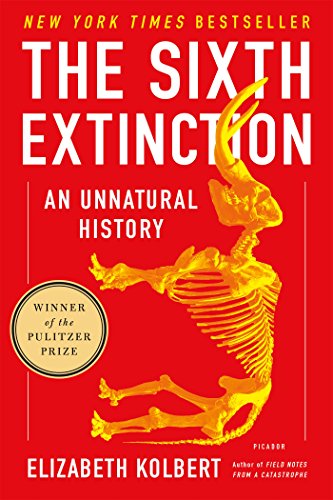
A major book about the future of the world, blending intellectual and natural history and field reporting into a powerful account of the mass extinction unfolding before our eyes.
Over the last half-billion years, there have been Five mass extinctions, when the diversity of life on earth suddenly and dramatically contracted. Scientists around the world are currently monitoring the sixth extinction, predicted to be the most devastating extinction event since the asteroid impact that wiped out the dinosaurs. This time around, the cataclysm is us.
In prose that is at once frank, entertaining, and deeply informed, New Yorker writer Elizabeth Kolbert tells us why and how human beings have altered life on the planet in a way no species has before. Interweaving research in half a dozen disciplines, descriptions of the fascinating species that have already been lost, and the history of extinction as a concept, Kolbert provides a moving and comprehensive account of the disappearances occurring before our very eyes. She shows that the sixth extinction is likely to be mankind’s most lasting legacy, compelling us to rethink the fundamental question of what it means to be human.
Elizabeth Kolbert | Oregon State University on YouTube.
The Sixth Extinction Quotes
“Though it might be nice to imagine there once was a time when man lived in harmony with nature, it’s not clear that he ever really did.”
“Today, amphibians enjoy the dubious distinction of being the world’s most endangered class of animals; it’s been calculated that the group’s extinction rate could be as much as forty-five thousand times higher than the background rate. But extinction rates among many other groups are approaching amphibian levels. It is estimated that one-third of all reef-building corals, a third of all freshwater mollusks, a third of sharks and rays, a quarter of all mammals, a fifth of all reptiles, and a sixth of all birds are headed toward oblivion. The losses are occurring all over: in the South Pacific and in the North Atlantic, in the Arctic and the Sahel, in lakes and on islands, on mountaintops and in valleys. If you know how to look, you can probably find signs of the current extinction event in your own backyard.”
“Among the many geologic-scale changes people have effected, Crutzen cited the following:
- Human activity has transformed between a third and a half of the land surface of the planet.
- Most of the world’s major rivers have been dammed or diverted.
- Fertilizer plants produce more nitrogen than is fixed naturally by all terrestrial ecosystems.
- Fisheries remove more than a third of the primary production of the oceans’ coastal waters.
- Humans use more than half of the world’s readily accessible fresh water runoff.
Most significantly, Crutzen said, people have altered the composition of the atmosphere. Owing to a combination of fossil fuel combustion and deforestation, the concentration of carbon dioxide in the air has risen by forty percent over the last two centuries, while the concentration of methane, an even more potent greenhouse gas, has more than doubled.”